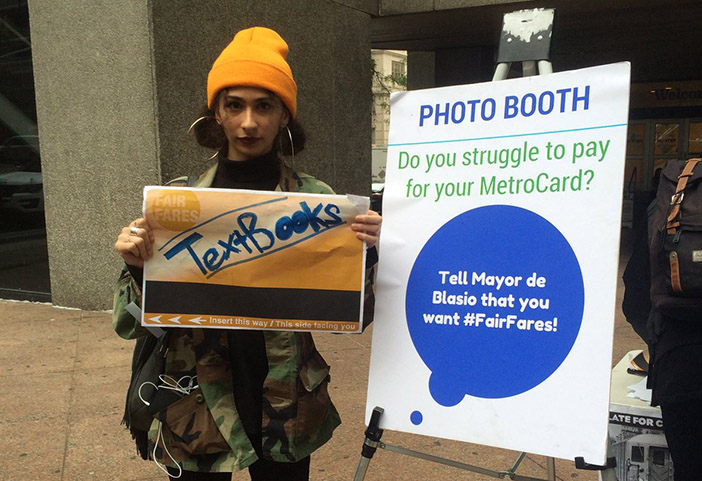Photo Courtesy of NYPIRG @ Hunter College
The #FairFares tour features images in which low-income students tell Mayor de Blasio how the cost of a MetroCard has been a barrier to their higher education.
By Forum Staff
The New York Public Interest Research Group Straphangers Campaign last week helped to expand the #FairFares Photo Petition Tour to include college commuters who want to show Mayor Bill de Blasio “the unfair choices low-income students face to afford public transit.”
Volunteers and students stood outside Hunter College at the 68th Street 6 train station last Thursday in Manhattan to announce the expansion of the tour that was initiated by members of the Riders Alliance in August. In the photos, low-income students use props of necessities – e.g. textbooks, meals – to illustrate how the cost of a MetroCard “has been a barrier to their higher education,” according to the Riders Alliance, which noted that a monthly MetroCard costs approximately $1,400 annually – more than the average price of textbooks (approximately $1,200 a year).
That’s why the Community Service Society, the Riders Alliance and 25 other organizations have said that they are calling on the mayor to implement half-priced subway and bus fares for low-income New Yorkers.
“Low-income students forgo meals, their textbooks or even skip class entirely,” said Straphangers Campaign Associate Jaqi Cohen. “When we saw the #FairFares photo tour launch, our volunteers were inspired to help students share their stories with Mayor de Blasio. We know that education is the primary way in which people can pull themselves out of poverty. But the ticket, the MetroCard, is getting in the way. Creating a reduced-fare system has the potential for benefiting thousands of CUNY students living below the federal poverty line, easing the already tremendous burden of paying for college.”
According to a CSS study released in April, one in four low-income New Yorkers reported being unable to travel to doctor’s appointments, jobs, college classes, and other essentials. The same report found that the cost of a 30-day unlimited MetroCard makes up more than 10 percent of a family’s budget, forcing individuals to make sacrifices, including fundamentals like rent, food, textbooks, and utilities. New York City provides limited-use MetroCards to public school students under 18, but they are cut off once they graduate, the Riders Alliance noted.
“This is a crisis. If low-income students are unable to get to the classes that will help them get a job upon graduation, than there is no real opportunity for upward mobility,” said Riders Alliance Campaign Manager Rebecca Bailin. “Mayor de Blasio has been looking for ways to help ease the growing economic inequality in this city. Luckily, #FairFares is a simple solution that will allow Mayor de Blasio to help low-income students, along with hundreds of thousands of other struggling New Yorkers, get ahead.”
According to the Alliance, as of 2014, 18 percent of CUNY students live below the federal poverty level, with some 40,000 CUNY students part of households earning a combined $10,000 a year or less.
“Taking mass transit to class is a right, not a luxury. I don’t think deciding between getting to class and purchasing textbooks should be a choice I or any student should make. I have to carefully plan my route by walking a long time from the Bronx to Harlem so I only have to take one bus to the train instead of two,” said Alejandro Brown, a sophomore at Hunter. “Mayor de Blasio: we need your help. Nobody should have to make these complicated calculations to get to school.”

